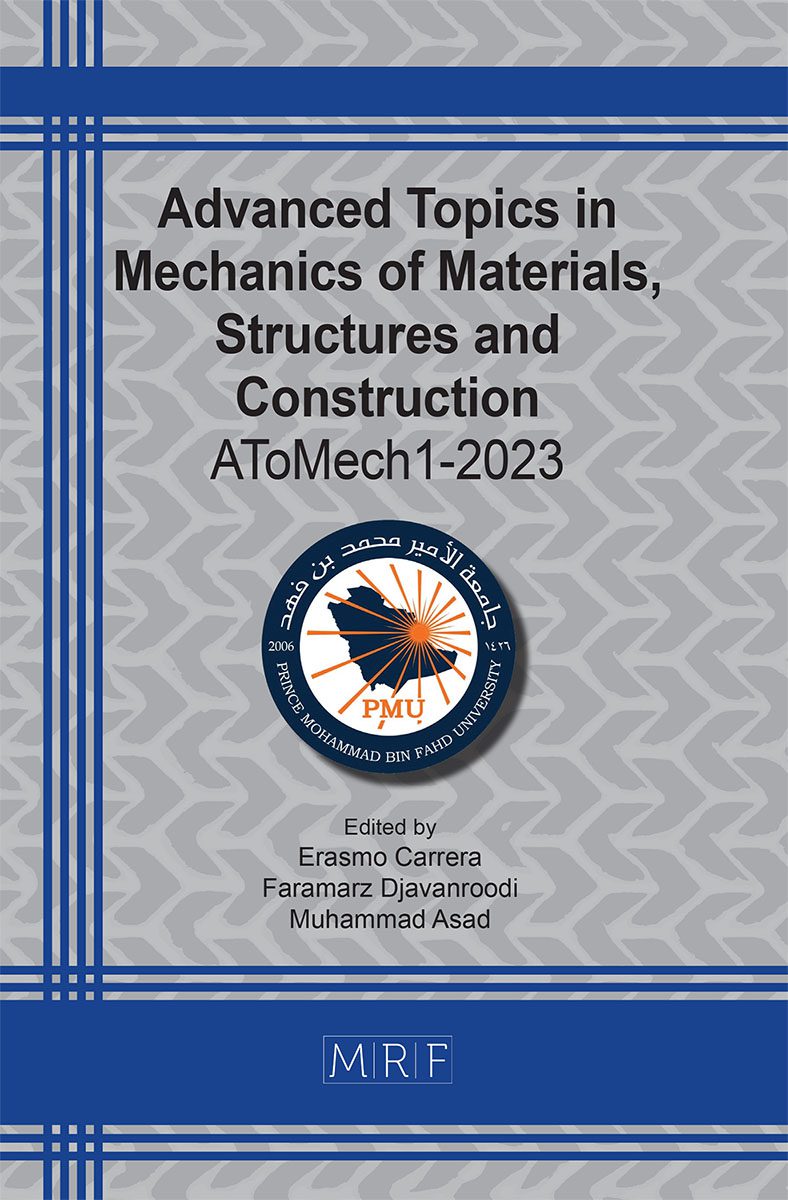Investigation of blast resistance of cladding with square dome-shaped Kirigami folded structures as core
Vishal M Birari, B N Rao
download PDFAbstract. This study examines the response of Square Dome-shaped Kirigami (SDK) structures when used as a core in cladding systems under blast loading conditions. A numerical model of the SDK foldcore is developed on the commercially available software ABAQUS. The SDK foldcore made of an aluminium sheet is placed between two rigid plates. The model is put under a quasi-static compression test to simulate the crushing effect and the results are used to calibrate the simulation with the experimental data from the literature. To evaluate the blast resistance of the system, four different levels of blast loading conditions are applied to the top of the top plate using Trinitrotoluene (TNT) explosive, with a distance of 1500 mm from the centre of the top plate. The structural response of the SDK foldcore is then compared with that of a traditional Square Honey Comb (SHC) core under the same blast loading conditions. This study aims to evaluate the relative performance of the two different cores in terms of their ability to mitigate the effects of blast loading. The SDK foldcore demonstrated the capability to disperse blast energy over a wider area, thus decreasing the stress the cladding system experienced. The results of the study show that SDK foldcore provides a significant improvement in energy absorption, with a maximum reduction of 70% in the peak load transmitted compared to the case with no cladding. The peak load transmitted by the SDK foldcore is much more consistent than the SHC core, even under different blast loading conditions. This is due to its favourable plastic deformation, which prevents complete densification. These results suggest that the SDK folded structure has better performance in mitigating the effects of blast loading.
Keywords
Kirigami, Foldcore, Sacrificial Cladding, Quasi-Static Compression, Blast Load
Published online 8/10/2023, 10 pages
Copyright © 2023 by the author(s)
Published under license by Materials Research Forum LLC., Millersville PA, USA
Citation: Vishal M Birari, B N Rao, Investigation of blast resistance of cladding with square dome-shaped Kirigami folded structures as core, Materials Research Proceedings, Vol. 31, pp 375-384, 2023
DOI: https://doi.org/10.21741/9781644902592-39
The article was published as article 39 of the book Advanced Topics in Mechanics of Materials, Structures and Construction
![]() Content from this work may be used under the terms of the Creative Commons Attribution 3.0 license. Any further distribution of this work must maintain attribution to the author(s) and the title of the work, journal citation and DOI.
Content from this work may be used under the terms of the Creative Commons Attribution 3.0 license. Any further distribution of this work must maintain attribution to the author(s) and the title of the work, journal citation and DOI.
References
[1] Lu, G., and T. Yu. 2003. Energy Absorption of Structures and Materials. Energy Absorpt. Struct. Mater.
[2] Xue, Z., and J. W. Hutchinson. 2004. “A comparative study of impulse-resistant metal sandwich plates.” Int. J. Impact Eng., 30 (10): 1283–1305. https://doi.org/10.1016/j.ijimpeng.2003.08.007
[3] Ousji, H., B. Belkassem, M. A. Louar, B. Reymen, J. Martino, D. Lecompte, L. Pyl, and J. Vantomme. 2017. “Air-blast response of sacrificial cladding using low density foams: Experimental and analytical approach.” Int. J. Mech. Sci., 128–129: 459–474. https://doi.org/10.1016/j.ijmecsci.2017.05.024
[4] Nurick, G. N., G. S. Langdon, Y. Chi, and N. Jacob. 2009. “Behaviour of sandwich panels subjected to intense air blast – Part 1: Experiments.” Compos. Struct., 91 (4): 433–441. Elsevier Ltd. https://doi.org/10.1016/j.compstruct.2009.04.009
[5] Wu, C., and Y. Zhou. 2011. “Simplified Analysis of Foam Cladding Protected Reinforced Concrete Slabs against Blast Loadings.” Int. J. Prot. Struct., 2 (3): 351–365. SAGE Publications. https://doi.org/10.1260/2041-4196.2.3.351
[6] Miura, K. 1972. Zeta-Core Sandwich- Its Concept and Realization. Institute of Space and Aeronautical Science, University of Tokyo.
[7] Miura, K. 1985. “Method of Packaging and Deployment of Large Membranes in Space.” Inst. Sp. Astronaut. Sci. Rep., 618: 1–9. 宇宙科学研究所.
[8] Gattas, J. M., and Z. You. 2014. “Quasi-static impact of indented foldcores.” Int. J. Impact Eng., 73: 15–29. https://doi.org/10.1016/j.ijimpeng.2014.06.001
[9] Fathers, R. K., J. M. Gattas, and Z. You. 2015. “Quasi-static crushing of eggbox, cube, and modified cube foldcore sandwich structures.” Int. J. Mech. Sci., 101–102: 421–428. Elsevier. https://doi.org/10.1016/j.ijmecsci.2015.08.013
[10] Li, Z., W. Chen, and H. Hao. 2018. “Blast mitigation performance of cladding using square dome-shape kirigami folded structure as core.” Int. J. Mech. Sci., 145 (July): 83–95. Elsevier Ltd. https://doi.org/10.1016/j.ijmecsci.2018.06.035
[11] Gattas, J. M., and Z. You. 2015. “The behaviour of curved-crease foldcores under low-velocity impact loads.” Int. J. Solids Struct.
[12] Dewey, J. M. 2018. “The Friedlander Equations.” Blast Eff. Phys. Prop. Shock Waves, I. Sochet, ed., 37–55. Cham: Springer International Publishing.
[13] “Conventional Weapons Effects Program (CONWEP).” 1986. Tech. Man. TM5-855-1, Fundam. Prot. Des. Conv. Weapons.































